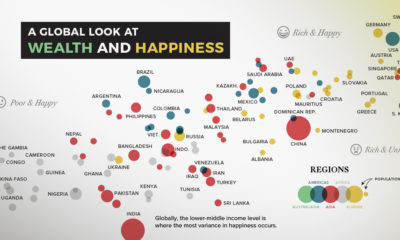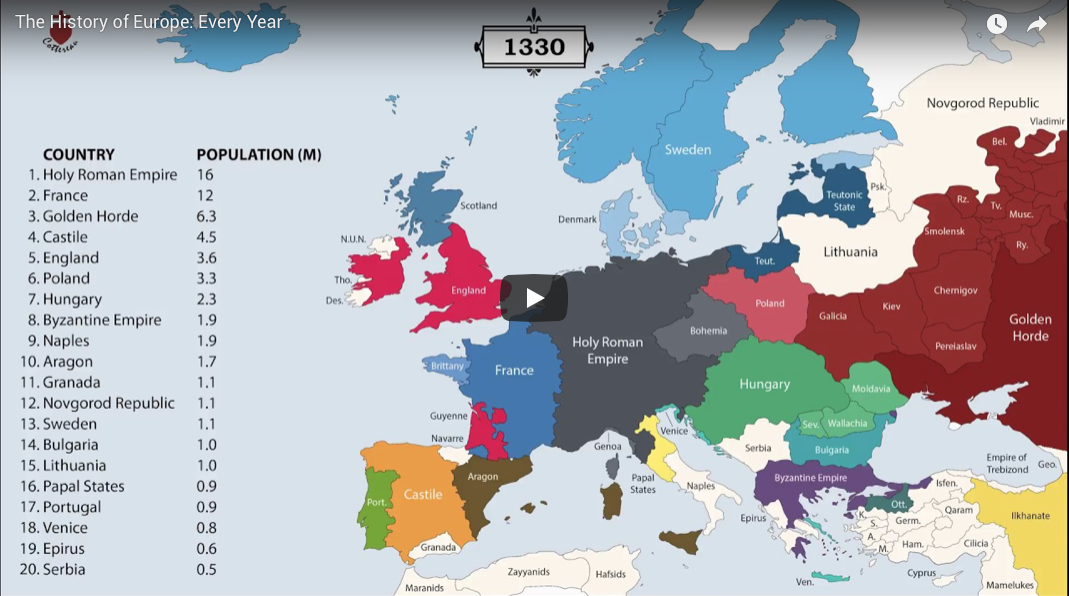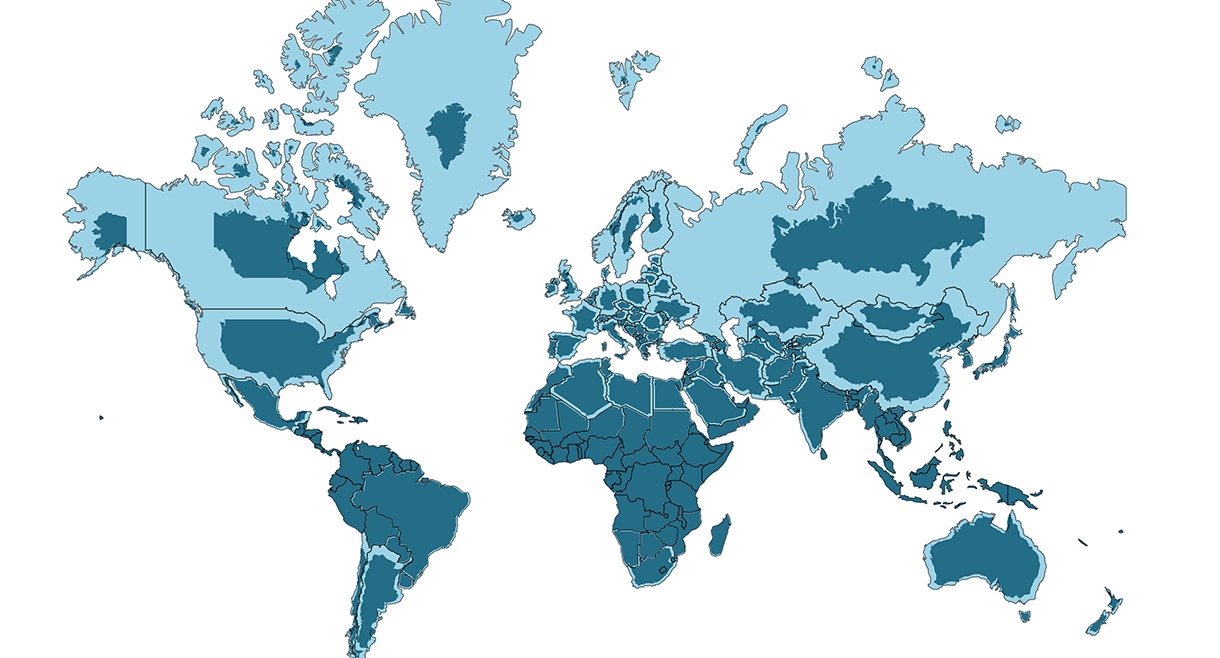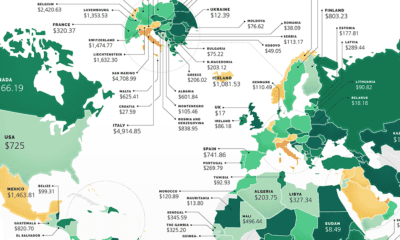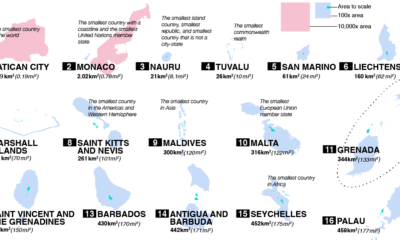In the context of modern times, flags are best known as national symbols — and they’re used to air a country’s past, present, and future vision all rolled into one.
The Meaning of Flags
Today’s infographic from Just the Flight looks at some the world’s most iconic flags, and the intricate stories and ideals that can be found in their designs.
The Americas
Since 1777, the star-spangled banner of the United States has gone through several facelifts. The current version has been in use since Hawaii gained statehood in 1960. Puerto Rico has been voting to become the 51st state in recent years — and if the U.S. government proved to accept such a resolution, the flag would be amended once more.
Europe
Denmark holds the Guinness world record for the oldest continuous use of their national flag, since 1625. The Danish flag is known as the Dannebrog, or Danish Cloth — as legend has it, the Dannebrog ‘miraculously’ fell from the sky in a battle during the Northern Crusades. The Union Jack of the United Kingdom combines aspects of three older national flags and was adopted in 1801. Displaying the flag upside down is considered lèse-majesté — “to do wrong to majesty”, or an insult to the Crown — and is offensive to some.
Asia and Oceania
India’s tricolor flag was first flown in 1923. However, the colors do not represent religions or hours in the day — saffron symbolizes indifference to material gains, the white band represents light while the navy blue Dharma Chakra (wheel of truth) depicts dynamic change, and green demonstrates the country’s relationship to nature. New Zealand’s flag features elements from the British Commonwealth. Since 2015, there have been ongoing debates among Kiwis about whether to amend the flag’s design. Frequent confusion with Australia is a significant pro for change, but national identity and financial costs are strong arguments against it. Nepal is the only country without a rectangular (or square) national flag. The two triangles pay tribute to its geographic location in the Himalayas as well as the Shah and Rana dynasties. The sun and moon symbols on the flag used to have human faces on them, but were removed in 1962.
Africa
South Africa boasts one of the world’s most colorful flags. When it was first adopted after Nelson Mandela’s release from prison, it was the first world flag to have six colors but no seal or brocade. Interestingly, while there is no inherent meaning in its colors, the Y shape symbolizes the convergence of diverse elements and societal unity. Mozambique is the only national flag in the world to feature a modern weapon – specifically, an AK-47 with an attached bayonet. Adopted in 1983, the rifle represents vigilance and defense, while the hoe crossing it represents the country’s agriculture. on Even while political regimes across these countries have changed over time, they’ve largely followed a few different types of governance. Today, every country can ultimately be classified into just nine broad forms of government systems. This map by Truman Du uses information from Wikipedia to map the government systems that rule the world today.
Countries By Type of Government
It’s important to note that this map charts government systems according to each country’s legal framework. Many countries have constitutions stating their de jure or legally recognized system of government, but their de facto or realized form of governance may be quite different. Here is a list of the stated government system of UN member states and observers as of January 2023: Let’s take a closer look at some of these systems.
Monarchies
Brought back into the spotlight after the death of Queen Elizabeth II of England in September 2022, this form of government has a single ruler. They carry titles from king and queen to sultan or emperor, and their government systems can be further divided into three modern types: constitutional, semi-constitutional, and absolute. A constitutional monarchy sees the monarch act as head of state within the parameters of a constitution, giving them little to no real power. For example, King Charles III is the head of 15 Commonwealth nations including Canada and Australia. However, each has their own head of government. On the other hand, a semi-constitutional monarchy lets the monarch or ruling royal family retain substantial political powers, as is the case in Jordan and Morocco. However, their monarchs still rule the country according to a democratic constitution and in concert with other institutions. Finally, an absolute monarchy is most like the monarchies of old, where the ruler has full power over governance, with modern examples including Saudi Arabia and Vatican City.
Republics
Unlike monarchies, the people hold the power in a republic government system, directly electing representatives to form government. Again, there are multiple types of modern republic governments: presidential, semi-presidential, and parliamentary. The presidential republic could be considered a direct progression from monarchies. This system has a strong and independent chief executive with extensive powers when it comes to domestic affairs and foreign policy. An example of this is the United States, where the President is both the head of state and the head of government. In a semi-presidential republic, the president is the head of state and has some executive powers that are independent of the legislature. However, the prime minister (or chancellor or equivalent title) is the head of government, responsible to the legislature along with the cabinet. Russia is a classic example of this type of government. The last type of republic system is parliamentary. In this system, the president is a figurehead, while the head of government holds real power and is validated by and accountable to the parliament. This type of system can be seen in Germany, Italy, and India and is akin to constitutional monarchies. It’s also important to point out that some parliamentary republic systems operate slightly differently. For example in South Africa, the president is both the head of state and government, but is elected directly by the legislature. This leaves them (and their ministries) potentially subject to parliamentary confidence.
One-Party State
Many of the systems above involve multiple political parties vying to rule and govern their respective countries. In a one-party state, also called a single-party state or single-party system, only one political party has the right to form government. All other political parties are either outlawed or only allowed limited participation in elections. In this system, a country’s head of state and head of government can be executive or ceremonial but political power is constitutionally linked to a single political movement. China is the most well-known example of this government system, with the General Secretary of the Communist Party of China ruling as the de facto leader since 1989.
Provisional
The final form of government is a provisional government formed as an interim or transitional government. In this system, an emergency governmental body is created to manage political transitions after the collapse of a government, or when a new state is formed. Often these evolve into fully constitutionalized systems, but sometimes they hold power for longer than expected. Some examples of countries that are considered provisional include Libya, Burkina Faso, and Chad.

